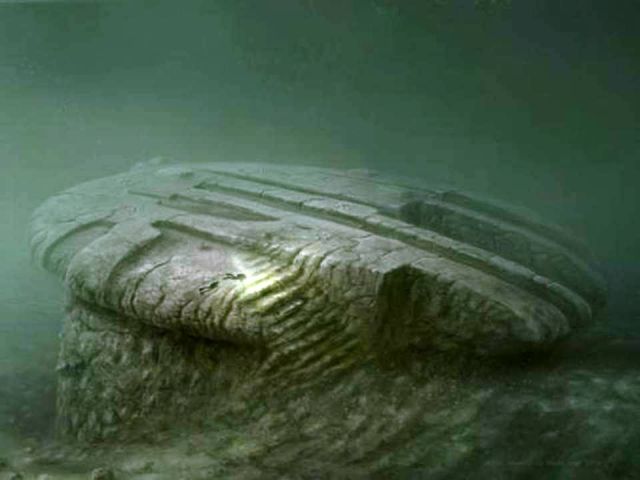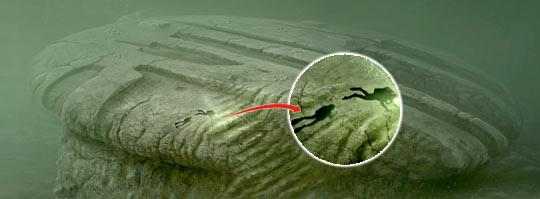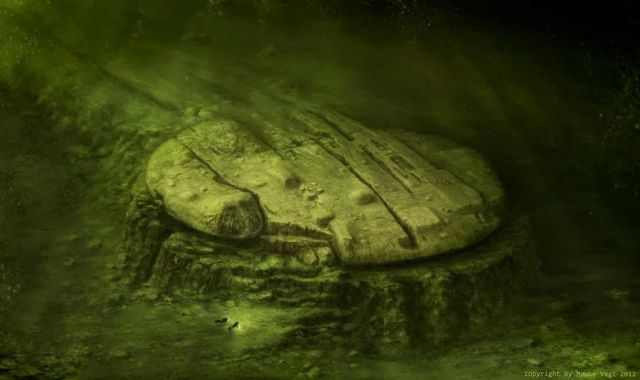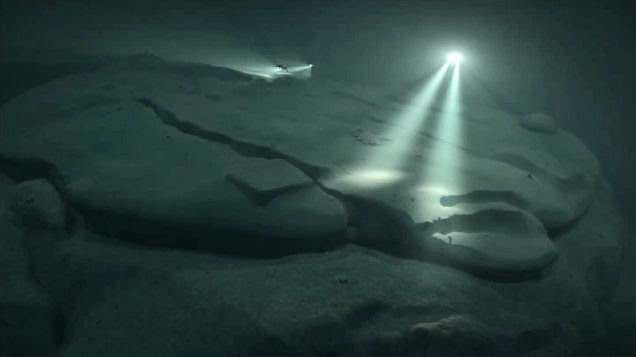
“It is not an object which is man made in modern time. What ever it is it’s either from during the ice age or pre-ice age.” – Peter Lindberg, February 24, 2013 “The object is older than 140.000 yrs. Older than that… with straight angles/lines – rounded corners… much like a “dinner plate” and separate from the base below.” – Dennis Asberg, September 28, 2012
There are THREE objects of interest – 1) the main 60 meter circular anomaly, 2) a smaller secondary object lying approx. 200 meters from the 1st anomaly with an area shaped like two “Gothic church windows” and 3) a third anomaly – a 28 meters high and 275 meters wide rock outcrop with a crack running through it, lying some 1500 metres South of the circular object, direct on the other end of the “trail”. The team has stated Anomaly 2 might turn out to be the most interesting than the first, and they plan to dive on it this time around



Subscribe on Youtube Guys - https://www.youtube.com/user/MRSTARGAZERNATION

The object lies at approx. 85-90 meter depth in international waters between Sweden & Finland
Conditions at site are poor – visibility is low – 2-3 feet, low light levels, low temperatures.
60 meter in diameter, 4 meters thick
Perfectly round, somewhat flattened dome-shaped object made of a “rock-like” substance, although it is not a rock formation. There are rock formations, which appear on the surface of the object. (This is what a sample was taken of on the second expedition, NOT of the circular object itself. “They hammered off a couple of pieces from a huge rock formation on top of the circle, but it seems like that part is not really a part of the larger circular body. We were thinking that if it is a volcano the material with the smooth surface maybe was basalt and that the rocks on top were ordinary rock that has been broke and pushed up on top of the magma. But since the divers hardly could not see anything they just took samples from where they landed and that was on the highest point.” – Peter Lindberg, July 22, 2012)
The object seems to be very very old, rare and something the crew has never seen before. (Peter Lindberg feels that it could be Pre-ice age.) “I think you must think of this object being there for a very long time, natural or made in some way.” – Peter Lindberg, July 22, 2012
“When I say the anomaly is not a rock i mean that it is not a solid block of granite or some other “stone”. (like ayers rock in Ausralia) That is the definition I have of a rock. The anomaly is made of some other material which I do not know what it is but I´m sure there are several different materials @ the sight, you have 5-10 meter deep layer of clay, that lies on top of the Scandinavian rock. On top of the clay lies this anomaly, and on top of the anomaly small stones of different kind.” ~ Stefan Hogeborn November 13, 2012 When asked if the anomaly was metal, Peter Lindberg answered, “Nothing like any metal I know any way.” June 8, 2012
It seems like the circle is covered in a very thin layer of sediment, but at certain locations the silt is thicker, nearly like clay. I guess that the currents can stir the silt up at these locations. When the divers scraped it off a blackish surface appeared underneath.
Nearly the entire anomaly seems to be of the same material except a piece of cliff where I have marked the black ring for the hole and the blue ring where the the drop weight landed on the second dive. (south on the anomaly). The team is not sure if it is just rocks which are laying on the anomaly or if it is a part of it.
The surface of the circle is not entirely smooth, in some places it is cracking. It appears to be covered in some type of hard cement-like substance, mineral deposit. After being chipped, the interior of object is black, like volcanic rock, almost petrified inside. Material is very hard, not simple stone, described as “preserved rock”. Hogeborn describes the sense of carbonized material.
The object has rounded sides with rugged edges (not smooth). “It’s like someone has pinched the mountain at the edge, as if you have moulded together two molds, and it sticks out stones between the molds”,- Stefan Hogeborn. “We can see this phenomena at several different points on the anomaly. It appear to occur where we have these structural corridoors, cracks and such things.” – Peter Lindberg
There are two round holes in the circle. One is 30 cm wide, and the other is approx. 2 meters wide and surrounded by a square formation of 2 x 2 meters.
There are not only straight lined formations on the circle, there appear to have construction lines and boxes drawn on it.
90 degree angle corridors 1.5 meters in height and 3 meter wide, which are cut into the object.
Divers said there was a “blackish” powder that had been attracted to the cameras.
Looks like something has been very hot down there, so that the stone has melted. Dennis believes this to be true because “some stones look like their up side is burned. Also the blackish material which looks like it has been poured out gives the sense that it might been some heat down there.” – Peter Lindberg, July 4, 2012“The surface of the (circular) object has cracks in it in some places 1-2 inches wide, and in these cracks, it looks like something has poured out like magma…If the magma had come out before the ice age, it should have been scraped away by the ice, but now it’s there like it poured out yesterday.” – Earthfiles interview with Peter Lindberg ” As you understand it is very much in this that points toward this not being just a “stone formation”. “The cracks seams not to be irregular, they seams to go vertically or horizontally. Behind them you can see a blackish colored mineral(?) with the structure of old wooden planks.” – Peter Lindberg, June 21, 2012
Dennis said that a volcano is possible, however according to researchers, there has never been a volcanic activity in the Baltic Sea. Also, the object they found doesn’t look like a volcano because of the perfect circular form of it and also because of the 90 degree angles. Peter Lindberg, on the other hand feels they have found volcanic activity (see below) and this volcano-like mountain (approx. 2 km away from the anomaly) will be looked at on their next expedition.
Conditions at site are poor – visibility is low – 2-3 feet, low light levels, low temperatures.
60 meter in diameter, 4 meters thick
Perfectly round, somewhat flattened dome-shaped object made of a “rock-like” substance, although it is not a rock formation. There are rock formations, which appear on the surface of the object. (This is what a sample was taken of on the second expedition, NOT of the circular object itself. “They hammered off a couple of pieces from a huge rock formation on top of the circle, but it seems like that part is not really a part of the larger circular body. We were thinking that if it is a volcano the material with the smooth surface maybe was basalt and that the rocks on top were ordinary rock that has been broke and pushed up on top of the magma. But since the divers hardly could not see anything they just took samples from where they landed and that was on the highest point.” – Peter Lindberg, July 22, 2012)
The object seems to be very very old, rare and something the crew has never seen before. (Peter Lindberg feels that it could be Pre-ice age.) “I think you must think of this object being there for a very long time, natural or made in some way.” – Peter Lindberg, July 22, 2012
“When I say the anomaly is not a rock i mean that it is not a solid block of granite or some other “stone”. (like ayers rock in Ausralia) That is the definition I have of a rock. The anomaly is made of some other material which I do not know what it is but I´m sure there are several different materials @ the sight, you have 5-10 meter deep layer of clay, that lies on top of the Scandinavian rock. On top of the clay lies this anomaly, and on top of the anomaly small stones of different kind.” ~ Stefan Hogeborn November 13, 2012 When asked if the anomaly was metal, Peter Lindberg answered, “Nothing like any metal I know any way.” June 8, 2012
It seems like the circle is covered in a very thin layer of sediment, but at certain locations the silt is thicker, nearly like clay. I guess that the currents can stir the silt up at these locations. When the divers scraped it off a blackish surface appeared underneath.
Nearly the entire anomaly seems to be of the same material except a piece of cliff where I have marked the black ring for the hole and the blue ring where the the drop weight landed on the second dive. (south on the anomaly). The team is not sure if it is just rocks which are laying on the anomaly or if it is a part of it.
The surface of the circle is not entirely smooth, in some places it is cracking. It appears to be covered in some type of hard cement-like substance, mineral deposit. After being chipped, the interior of object is black, like volcanic rock, almost petrified inside. Material is very hard, not simple stone, described as “preserved rock”. Hogeborn describes the sense of carbonized material.
The object has rounded sides with rugged edges (not smooth). “It’s like someone has pinched the mountain at the edge, as if you have moulded together two molds, and it sticks out stones between the molds”,- Stefan Hogeborn. “We can see this phenomena at several different points on the anomaly. It appear to occur where we have these structural corridoors, cracks and such things.” – Peter Lindberg
There are two round holes in the circle. One is 30 cm wide, and the other is approx. 2 meters wide and surrounded by a square formation of 2 x 2 meters.
There are not only straight lined formations on the circle, there appear to have construction lines and boxes drawn on it.
90 degree angle corridors 1.5 meters in height and 3 meter wide, which are cut into the object.
Divers said there was a “blackish” powder that had been attracted to the cameras.
Looks like something has been very hot down there, so that the stone has melted. Dennis believes this to be true because “some stones look like their up side is burned. Also the blackish material which looks like it has been poured out gives the sense that it might been some heat down there.” – Peter Lindberg, July 4, 2012“The surface of the (circular) object has cracks in it in some places 1-2 inches wide, and in these cracks, it looks like something has poured out like magma…If the magma had come out before the ice age, it should have been scraped away by the ice, but now it’s there like it poured out yesterday.” – Earthfiles interview with Peter Lindberg ” As you understand it is very much in this that points toward this not being just a “stone formation”. “The cracks seams not to be irregular, they seams to go vertically or horizontally. Behind them you can see a blackish colored mineral(?) with the structure of old wooden planks.” – Peter Lindberg, June 21, 2012
Dennis said that a volcano is possible, however according to researchers, there has never been a volcanic activity in the Baltic Sea. Also, the object they found doesn’t look like a volcano because of the perfect circular form of it and also because of the 90 degree angles. Peter Lindberg, on the other hand feels they have found volcanic activity (see below) and this volcano-like mountain (approx. 2 km away from the anomaly) will be looked at on their next expedition.
“The entire anomaly has a thin layer of silt on it and when the divers scraped it off a blackish surface appeared underneath. Nearly the entire anomaly seams to be of the same material except a piece of cliff where I have marked the black ring for the hole and the blue ring where the the drop weight landed on the second dive. We do not know if that rocks just lays on the anomaly or if it is a part of it.“There is nearly no silt at all on the anomaly, just a very thin layer. You can clearly see the structure of the surface through the silt. I as diver would refer it to what you find on ships hull. You can clearly see the color but when you brush with your hand over the surface you notice it is a “slimy” layer on it.

The circular object rests upon a 8 meter tall pillar/foundation. “The foundation is more that it has “popped up” like a cork or it has always been there but being partly exposed by the ice or currents. It is more of a solid cliff than bottom being pushed together to a conglomerate”- Peter LindbergThe foundation increases in thickness, to a dimension of 56 meters near the top where it meets the object. On one side of circle (front), the object is extending approximately 4-6 meters off from pillar. The object does not appear to be connected to the pillar. There is a wedge formed gap between the upper part (the circle) and the lower part (pillar foundation). Looks like granite, surface of anomaly is made of different material than pillar. “During the last expedition it was confirmed that there is a wedge formed gap between the upper part (the circle) and the lower part (foundation/pillar). However, if the two parts are completely separated or if the upper part and the lower part are the same object has not been clarified“.
